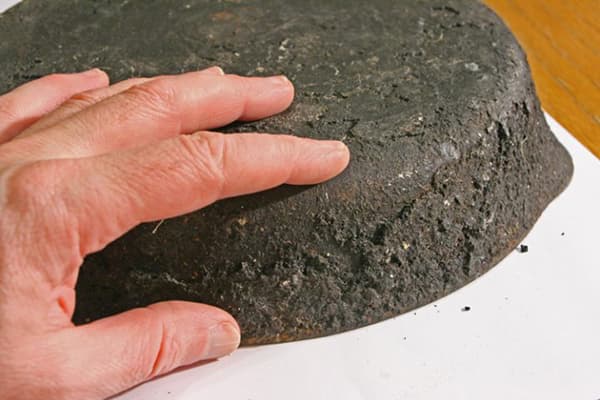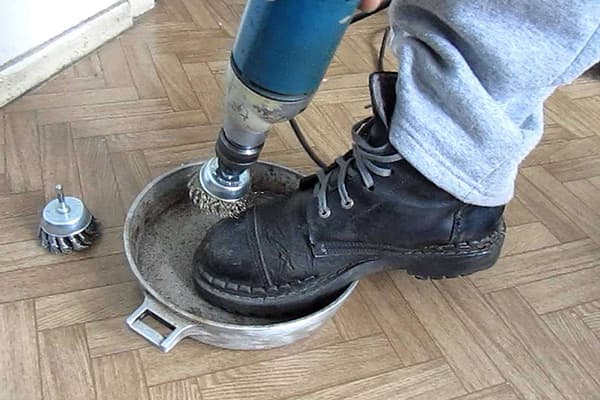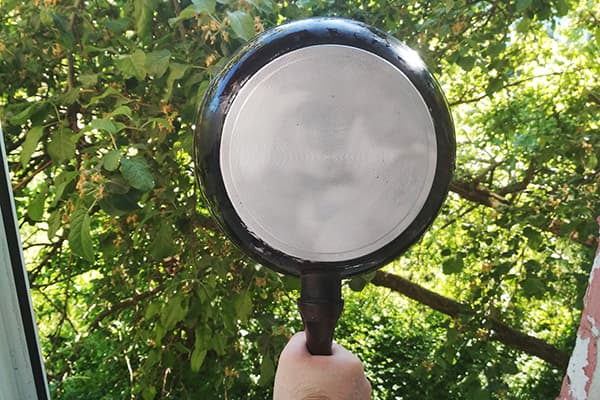Male approach: cleaning a pan from a pan with a drill
Content:
With improper care, a black deposit appears on the surface of the pan, which is not easy to clean. Good results are obtained by the method of mechanical cleaning of a pan from a deposit with a drill. However, if you act without knowing the technology, you can damage the surface, making the vessel unsuitable for further use. In addition, not all utensils can be cleaned with abrasives. We will figure out what and how to do so as not to spoil the pan and get a clean, shiny surface.
Where does the soot come from and why should it be cleaned?
In the process of cooking on the walls of the pan (as well as the stewpan, crepe maker, baking dish, etc.), durable black deposits are gradually formed, which are called soot. The composition of soot includes food combustion products (mainly burnt fats), dust, metal oxides, from which the dishes are made. If you do not systematically care for your kitchen utensils, the black crust will become thicker and thicker.
Sludge from cast iron or aluminum utensils is removed with great difficulty. These deposits have an unaesthetic appearance, and in addition, reduce the thermal conductivity of the pan. Because of this, the food warms up unevenly and becomes not so tasty. But the main harm of the scale is that its pieces can crack, falling into food. Such an “additive” can cause considerable harm to health.
Here are the reasons why carbon deposits must be cleaned:
- In a chemical analysis of soot, benzapyrene was found in its composition. This fat burning product has a carcinogenic ability, provoking the development of malignant tumors of the stomach. The harmful effects of benzapirene are enhanced by its ability to accumulate in the body. Therefore, systematically cooking in a scale covered with pan is harmful.
- Examination of the crust under a microscope showed that these deposits have not a continuous, but a spongy structure. Such a sponge is colonized by microorganisms. The waste they produce becomes an additional factor affecting health.
That is why it is necessary to regularly remove carbon deposits from the dishes. And although at home it’s not easy to clean a cast-iron baking sheet or aluminum crepe maker, today there are effective methods to quickly cope with soot.
A sandblasting machine is able to quickly and efficiently remove carbon deposits. You can find one in automobile and tire workshops. The cleaning service is inexpensive and does not take much time. However, there is a risk that microscopic cracks will appear in the metal, due to which the pan may break in the future.
Mechanical cleaning: pros and cons
For utensils that are not equipped with a non-stick coating, the most effective mechanical way to remove deposits. It involves the use of solid particles (abrasives) or metal tools with which carbon deposits are literally stripped from the surface.
This method has several advantages:
- Rapidity. The use of chemical solvents requires several days, and using a drill equipped with a metal brush, you can tear off carbon deposits in 20-40 minutes.
- Profitability. A bottle of a product that can dissolve soot is not cheap (at least 250-500 rubles). There is an electric drill in almost any home and is used for free.
- Efficiency. The surface is easily cleaned to a shine. Other means to achieve such a result are difficult.
There are also mechanical shortcomings.Hard metal and abrasives can damage the oxide film layer that protects the cast iron or aluminum from corrosion. And then the dishes will begin to rust, and the food cooked in it will get an unpleasant metallic aftertaste. To avoid this effect, after cleaning it is necessary to restore the oxide film.
Do not use a drill or wire brush to clean non-stick cookware, ceramic or Teflon pans. It is permissible to subject aluminum utensils to mechanical cleaning only outside.
How to clean a pan with a drill?
The procedure for cleaning the pan from soot with a drill looks like this:
- A tool is being prepared: a round brush is fixed to the drill for metal, and clamps on the table will hold the pan.
- Prepare the pan: remove the wooden or plastic handle, securely clamp the dish in the clamps.
- Put on overalls. Eyes need safety glasses, hands need thick gloves. These measures will protect the skin and mucous membranes from injury by particles of scale.
- Turn on the drill, clean the outside of the vessel from the sides.
- Remove deposits from the bottom from the outside.
- In conclusion, conduct cleaning of the inner surface (if the material allows).
The whole procedure takes about 30 minutes.
To facilitate cleaning, pre-heat the pan with a blowtorch. It can also be used to heat a gas stove. Annealing will soften plaque and speed up the cleaning process.
Cleaning the pan after cleaning
After removing carbon deposits by strong mechanical action, the metal loses its protective film from oxides. To restore it, pour oil into a pan and pour salt. Bring the oil to a boil. When the oil has cooled, the dishes are washed with water. After this procedure, the oxide film should recover.
In order not to encounter the unpleasant need to clean the pan from carbon deposits in the future, clean off contamination in a timely manner after each cooking.



Rich in fantasy Russian people!
Why bring to such a state that then clean with a drill?
I think it's better to buy a new one)